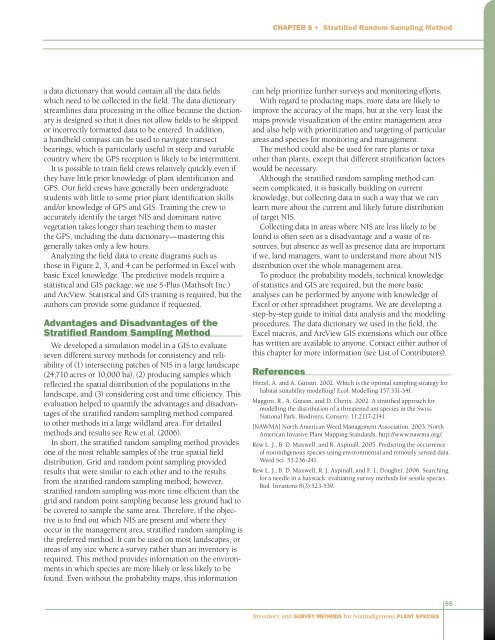Inventory and Survey Methods for Nonindigenous Plant Species (PDF)
Inventory and Survey Methods for Nonindigenous Plant Species (PDF)
Inventory and Survey Methods for Nonindigenous Plant Species (PDF)
- No tags were found...
Create successful ePaper yourself
Turn your PDF publications into a flip-book with our unique Google optimized e-Paper software.
Chapter 6 • Stratified R<strong>and</strong>om Sampling Methoda data dictionary that would contain all the data fieldswhich need to be collected in the field. The data dictionarystreamlines data processing in the office because the dictionaryis designed so that it does not allow fields to be skippedor incorrectly <strong>for</strong>matted data to be entered. In addition,a h<strong>and</strong>held compass can be used to navigate transectbearings, which is particularly useful in steep <strong>and</strong> variablecountry where the GPS reception is likely to be intermittent.It is possible to train field crews relatively quickly even ifthey have little prior knowledge of plant identification <strong>and</strong>GPS. Our field crews have generally been undergraduatestudents with little to some prior plant identification skills<strong>and</strong>/or knowledge of GPS <strong>and</strong> GIS. Training the crew toaccurately identify the target NIS <strong>and</strong> dominant nativevegetation takes longer than teaching them to masterthe GPS, including the data dictionary—mastering thisgenerally takes only a few hours.Analyzing the field data to create diagrams such asthose in Figure 2, 3, <strong>and</strong> 4 can be per<strong>for</strong>med in Excel withbasic Excel knowledge. The predictive models require astatistical <strong>and</strong> GIS package; we use S-Plus (Mathsoft Inc.)<strong>and</strong> ArcView. Statistical <strong>and</strong> GIS training is required, but theauthors can provide some guidance if requested.Advantages <strong>and</strong> Disadvantages of theStratified R<strong>and</strong>om Sampling MethodWe developed a simulation model in a GIS to evaluateseven different survey methods <strong>for</strong> consistency <strong>and</strong> reliabilityof (1) intersecting patches of NIS in a large l<strong>and</strong>scape(24,710 acres or 10,000 ha), (2) producing samples whichreflected the spatial distribution of the populations in thel<strong>and</strong>scape, <strong>and</strong> (3) considering cost <strong>and</strong> time efficiency. Thisevaluation helped to quantify the advantages <strong>and</strong> disadvantagesof the stratified r<strong>and</strong>om sampling method comparedto other methods in a large wildl<strong>and</strong> area. For detailedmethods <strong>and</strong> results see Rew et al. (2006).In short, the stratified r<strong>and</strong>om sampling method providesone of the most reliable samples of the true spatial fielddistribution. Grid <strong>and</strong> r<strong>and</strong>om point sampling providedresults that were similar to each other <strong>and</strong> to the resultsfrom the stratified r<strong>and</strong>om sampling method; however,stratified r<strong>and</strong>om sampling was more time efficient than thegrid <strong>and</strong> r<strong>and</strong>om point sampling because less ground had tobe covered to sample the same area. There<strong>for</strong>e, if the objectiveis to find out which NIS are present <strong>and</strong> where theyoccur in the management area, stratified r<strong>and</strong>om sampling isthe preferred method. It can be used on most l<strong>and</strong>scapes, orareas of any size where a survey rather than an inventory isrequired. This method provides in<strong>for</strong>mation on the environmentsin which species are more likely or less likely to befound. Even without the probability maps, this in<strong>for</strong>mationcan help prioritize further surveys <strong>and</strong> monitoring ef<strong>for</strong>ts.With regard to producing maps, more data are likely toimprove the accuracy of the maps, but at the very least themaps provide visualization of the entire management area<strong>and</strong> also help with prioritization <strong>and</strong> targeting of particularareas <strong>and</strong> species <strong>for</strong> monitoring <strong>and</strong> management.The method could also be used <strong>for</strong> rare plants or taxaother than plants, except that different stratification factorswould be necessary.Although the stratified r<strong>and</strong>om sampling method canseem complicated, it is basically building on currentknowledge, but collecting data in such a way that we canlearn more about the current <strong>and</strong> likely future distributionof target NIS.Collecting data in areas where NIS are less likely to befound is often seen as a disadvantage <strong>and</strong> a waste of resources,but absence as well as presence data are importantif we, l<strong>and</strong> managers, want to underst<strong>and</strong> more about NISdistribution over the whole management area.To produce the probability models, technical knowledgeof statistics <strong>and</strong> GIS are required, but the more basicanalyses can be per<strong>for</strong>med by anyone with knowledge ofExcel or other spreadsheet programs. We are developing astep-by-step guide to initial data analysis <strong>and</strong> the modelingprocedures. The data dictionary we used in the field, theExcel macros, <strong>and</strong> ArcView GIS extensions which our officehas written are available to anyone. Contact either author ofthis chapter <strong>for</strong> more in<strong>for</strong>mation (see List of Contributors).ReferencesHirzel, A. <strong>and</strong> A. Guisan. 2002. Which is the optimal sampling strategy <strong>for</strong>habitat suitability modelling? Ecol. Modelling 157:331-341.Maggini, R., A. Guisan, <strong>and</strong> D. Cherix. 2002. A stratified approach <strong>for</strong>modelling the distribution of a threatened ant species in the SwissNational Park. Biodivers. Conserv. 11:2117-2141.[NAWMA] North American Weed Management Association. 2003. NorthAmerican Invasive <strong>Plant</strong> Mapping St<strong>and</strong>ards. http://www.nawma.org/.Rew L. J., B. D. Maxwell, <strong>and</strong> R. Aspinall. 2005. Predicting the occurrenceof nonindigenous species using environmental <strong>and</strong> remotely sensed data.Weed Sci. 53:236-241.Rew L. J., B. D. Maxwell, R. J. Aspinall, <strong>and</strong> F. L. Dougher. 2006. Searching<strong>for</strong> a needle in a haystack: evaluating survey methods <strong>for</strong> sessile species.Biol. Invasions 8(3):523-539.55<strong>Inventory</strong> <strong>and</strong> <strong>Survey</strong> <strong>Methods</strong> <strong>for</strong> <strong>Nonindigenous</strong> <strong>Plant</strong> <strong>Species</strong>
















